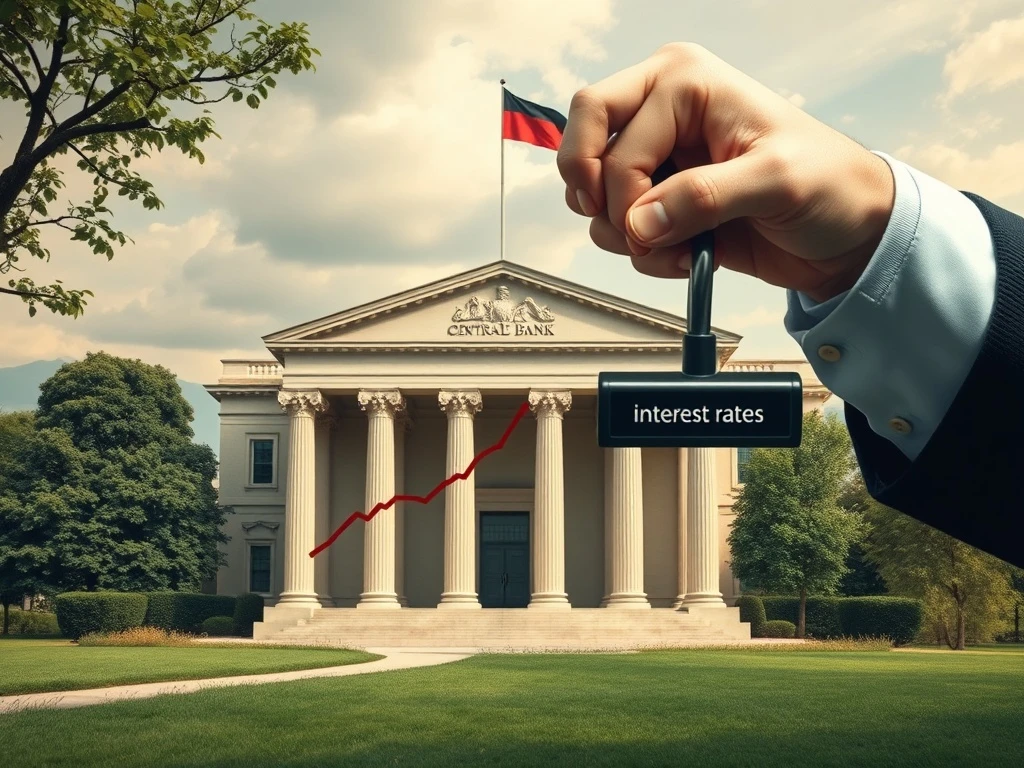Recent economic data has sent ripples through global financial markets. Specifically, a surprising surge in producer price inflation has significantly altered expectations for Federal Reserve interest rate cuts. This unexpected development presents a complex challenge for policymakers and investors alike, reshaping the economic outlook.
Understanding Producer Price Inflation’s Critical Role
Producer price inflation, often referred to as PPI, measures the average change over time in the selling prices received by domestic producers for their output. It serves as a crucial economic indicator. Furthermore, it offers an early glimpse into potential future consumer price trends.
For instance, when producers face higher costs, they often pass these increases onto consumers. Consequently, this can lead to broader inflation. The PPI covers a wide range of industries, from manufacturing to services. Thus, its movements provide valuable insights into the health and direction of the economy. Policymakers, therefore, monitor PPI closely to gauge inflationary pressures within the supply chain. Moreover, businesses use this data for pricing strategies and forecasting. Understanding producer price inflation is key to anticipating market shifts.
The Latest Producer Price Inflation Data Unveiled
The most recent report on producer price inflation delivered an unexpected jolt to markets. Data indicated a stronger-than-anticipated increase in prices at the wholesale level. This surge surprised many economists and analysts. Previously, expectations leaned towards a moderation in inflationary pressures. However, the actual figures painted a different picture. Key components, such as energy and services, showed notable price gains. This broad-based increase suggests underlying inflationary momentum.
For example, the core PPI, which excludes volatile food and energy prices, also rose. This particular metric is often viewed as a more reliable indicator of persistent inflation. Its upward movement signals that price pressures extend beyond just a few sectors. This unexpected strength in producer price inflation immediately impacted market sentiment. It forced a reevaluation of the current economic environment. Such data underscores the ongoing battle against inflation.
How Producer Price Inflation Impacts Fed Policy
The Federal Reserve’s primary objectives include maintaining maximum employment and price stability. Price stability essentially means controlling inflation. Therefore, inflation data, including producer price inflation, plays a pivotal role in the Fed’s decision-making process. A rise in PPI suggests that inflationary pressures are building from the production side. This can eventually filter down to consumer prices.
The Fed often considers PPI a leading indicator for the Consumer Price Index (CPI). Consequently, a persistent increase in producer costs makes the Fed’s job harder. They aim to bring inflation back to their 2% target. Higher PPI figures might necessitate a more cautious approach to monetary policy easing. This means interest rate cuts could be delayed. Historically, the Fed has responded to strong inflation data by holding rates steady or even raising them. This is done to cool down the economy. Therefore, the recent producer price inflation report has complicated the Fed’s path towards easing monetary policy.
Shifting Interest Rate Cut Bets Due to Producer Price Inflation
The latest producer price inflation report dramatically reshaped market expectations for interest rate cuts. Before this data, many investors anticipated several rate reductions throughout the year. These expectations were largely based on a perceived cooling of inflation. However, the surprisingly high PPI figures quickly tempered this optimism. Traders and analysts immediately adjusted their forecasts. They began pricing in fewer rate cuts, or even a later start to the easing cycle.
For instance, probabilities for a rate cut in the upcoming months significantly decreased. This shift reflects the market’s understanding that the Fed will likely remain hawkish. They prioritize fighting inflation. This unexpected turn has introduced considerable uncertainty into financial markets. It impacts everything from bond yields to equity valuations. The narrative has shifted from ‘when will cuts begin?’ to ‘will cuts even happen this year?’. This change underscores the sensitivity of market bets to key economic indicators like producer price inflation.
Broader Economic Implications of Inflation
Sustained inflation, particularly when it stems from the producer side, carries significant broader economic implications. Firstly, it erodes purchasing power. Consumers find their money buys less. This can lead to a decline in real wages. Secondly, businesses face higher input costs. This squeezes profit margins. Consequently, some companies may delay investments or reduce hiring. This could slow economic growth.
High inflation also creates uncertainty. This makes long-term financial planning difficult for both households and businesses. Moreover, it can disproportionately affect lower-income households. They spend a larger portion of their income on essential goods. These goods often experience the most significant price increases. Furthermore, persistent inflation can necessitate tighter monetary policy from the central bank. This means higher interest rates. Higher rates can slow economic activity further. They also increase borrowing costs for everyone. Thus, the unexpected rise in producer price inflation signals potential headwinds for overall economic stability and growth.
Market Reactions and Investor Sentiment
The market’s reaction to the unexpected surge in producer price inflation was immediate and notable. Stock markets generally saw declines. Investors reacted to the prospect of higher-for-longer interest rates. Higher rates typically make future corporate earnings less valuable. Bond yields, conversely, moved higher. This reflects reduced demand for bonds as investors anticipate less monetary easing. The U.S. dollar also strengthened against other major currencies. This is a common response when the Fed is expected to maintain a tighter monetary stance.
Investor sentiment became more cautious. Previously, a ‘soft landing’ scenario seemed plausible. This involved inflation cooling without a recession. However, the latest PPI data complicated this outlook. It suggested inflation remains stubborn. This uncertainty can lead to increased market volatility. Traders may reduce their risk exposure. This impacts various asset classes, including cryptocurrencies. Crypto markets, while distinct, often react to broader macroeconomic trends. A more hawkish Fed stance can lead to reduced liquidity and investor appetite for riskier assets. Therefore, the PPI report has cast a shadow over optimistic market forecasts.
The Path Ahead for Fed Interest Rate Decisions
The Federal Reserve now faces a more challenging path regarding its interest rate decisions. The recent producer price inflation data complicates their goal of achieving a ‘soft landing.’ This scenario involves bringing inflation down without triggering a recession. Policymakers will scrutinize upcoming economic reports even more closely. Key data points include the Consumer Price Index (CPI), employment figures, and retail sales. These will provide further clarity on the economy’s health and inflationary pressures.
The Fed has repeatedly stated its data-dependent approach. Therefore, a continued trend of elevated inflation, whether from producer or consumer prices, will likely reinforce a ‘higher for longer’ interest rate strategy. This means rates would remain elevated for an extended period. This stance aims to ensure inflation is decisively brought under control. However, it also carries the risk of slowing economic growth more significantly. The Fed’s next few meetings will be critical. Their decisions will largely depend on how these crucial economic indicators evolve in the coming months. The persistent nature of producer price inflation makes their job particularly intricate.
Expert Outlooks on Future Producer Price Inflation
Economic experts are now reassessing their forecasts for future producer price inflation. Many acknowledge that the path to disinflation might be bumpier than previously thought. Some analysts point to lingering supply chain issues. Others highlight robust demand in certain sectors. These factors could continue to fuel price increases at the producer level. Geopolitical events also add to the uncertainty. For example, energy price fluctuations can directly impact PPI. Most experts agree that the Fed will remain cautious. They will prioritize inflation control over immediate rate cuts. This outlook suggests that businesses and consumers should prepare for potentially elevated prices for a while longer. The consensus view leans towards a gradual, rather than rapid, decline in inflationary pressures. This makes the Fed’s job of timing rate adjustments particularly delicate. They must balance cooling the economy with avoiding an unnecessary downturn.
In conclusion, the unexpected rise in producer price inflation has undeniably complicated the Federal Reserve’s monetary policy outlook. It has forced a significant recalibration of interest rate cut expectations across global markets. This development underscores the ongoing battle against inflation and its profound impact on economic stability. Investors and policymakers will continue to monitor incoming data closely. The future trajectory of inflation, particularly from the producer side, will heavily influence the Fed’s next steps and the broader economic landscape.
Frequently Asked Questions (FAQs)
What is Producer Price Inflation (PPI)?
Producer Price Inflation (PPI) measures the average change over time in the selling prices received by domestic producers for their output. It reflects the prices businesses pay for raw materials, components, and services. Therefore, it acts as a leading indicator for consumer inflation.
How does producer price inflation affect the Federal Reserve’s decisions?
The Federal Reserve closely monitors producer price inflation because it can signal future consumer price trends. If PPI rises significantly, it suggests businesses face higher costs, which they might pass on to consumers. This can lead to broader inflation. The Fed might then delay interest rate cuts or even consider rate hikes to combat these inflationary pressures and maintain price stability.
Why did the latest PPI report shock markets?
The latest PPI report shocked markets because it showed a stronger-than-expected increase in wholesale prices. This contradicted earlier expectations for moderating inflation. The surprising strength in producer price inflation suggested that underlying price pressures were more persistent than anticipated, leading investors to revise their expectations for Fed interest rate cuts.
What are the broader economic implications of high producer price inflation?
High producer price inflation can have several broad economic implications. It can lead to higher consumer prices, eroding purchasing power. Businesses may face reduced profit margins, potentially leading to slower investment and hiring. It also creates economic uncertainty and can necessitate tighter monetary policy, which means higher interest rates and potentially slower economic growth.
How does producer price inflation impact interest rate cut bets?
A rise in producer price inflation typically reduces the likelihood of immediate interest rate cuts. This is because the Federal Reserve prioritizes controlling inflation. If producer costs are increasing, it signals persistent inflationary pressures. Consequently, the Fed is more likely to maintain higher interest rates for longer to cool the economy and bring inflation back to its target, thereby delaying or reducing anticipated rate cuts.
Will rising producer price inflation lead to a recession?
Rising producer price inflation itself does not guarantee a recession. However, it increases the risk. If the Fed responds to persistent inflation by significantly raising or holding interest rates high, it could slow economic activity too much. This might lead to a recession. The Fed aims for a ‘soft landing,’ controlling inflation without causing a severe downturn, but rising producer price inflation complicates this goal.








